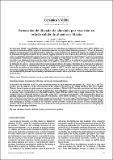Por favor, use este identificador para citar o enlazar a este item:
http://hdl.handle.net/10261/14946COMPARTIR / EXPORTAR:
 SHARE
BASE SHARE
BASE
|
|
| Visualizar otros formatos: MARC | Dublin Core | RDF | ORE | MODS | METS | DIDL | DATACITE | |

| Campo DC | Valor | Lengua/Idioma |
|---|---|---|
| dc.contributor.author | Baudín de la Lastra, Carmen | - |
| dc.contributor.author | Uribe, R. | - |
| dc.date.accessioned | 2009-07-15T10:49:01Z | - |
| dc.date.available | 2009-07-15T10:49:01Z | - |
| dc.date.issued | 2000-04 | - |
| dc.identifier.citation | Boletín de la Sociedad Española de Cerámica y Vidrio 39(2): 221-228 (2000) | en_US |
| dc.identifier.issn | 0366-3175 | - |
| dc.identifier.uri | http://hdl.handle.net/10261/14946 | - |
| dc.description.abstract | [ES] En el presente trabajo se ha estudiado el efecto que tienen las condiciones de tratamiento térmico (entre 1350 y 1650ºC) en la reacción de formación Al2TiO5, a partir de la mezcla equimolar de polvos finos (diámetro promedio < 0.5μm) de alúmina y titania de elevada pureza. Se ha determinado la influencia de las condiciones de tratamiento térmico en el grado de reacción de formación del Al2TiO5, el tamaño de las celdas de Al2TiO5 formadas y en la eficiencia de la posterior molienda de los materiales. Los compactos preparados a partir de la mezcla de los polvos, fueron prensados isostaticamente. Parte de los compactos fueron tratados térmicamente utilizando isotermas en el margen de temperaturas de 1350 y 1650ºC. Otros compactos fueron sometidos a un tratamiento térmico en dos etapas, tratados entre 1350 y 1500ºC y, a continuación se procedió a su molienda, posterior prensado y tratamiento utilizando isotermas a 1600ºC. La evolución de la reacción se estudió mediante las técnicas de difracción de rayos X, microscopía óptica y microscopía electrónica de barrido. El estudio de la eficiencia de molienda se llevo a cabo mediante un analizador de tamaño de partículas láser. Los resultados obtenidos indican la evolución de la reacción desde una matriz no reaccionada en compactos tratados a 1350°C, hasta la reacción prácticamente completa, salvo la presencia de partículas aisladas de alúmina dentro de la matriz de Al2TiO5, en compactos tratados a 1650°C. El tipo de microestructura del Al2TiO5 formado, determinada por el tratamiento térmico, afecta al posterior proceso de molienda de los materiales de Al2TiO5. | en_US |
| dc.description.abstract | [EN] In this work, the formation of Al2TiO5 from equimolar mixtures of high purity and fine grained (d50< 50μm) Al2O3 and TiO2 powders and the influence of the microstructure of the obtained compacts on the milling efficiency have been studied. Different thermal treatments with maximum temperatures between 1350 and 1650ºC have been considered and their influence in the degree of reaction and the cell size of Al2TiO5 have been established. Green compacts have been obtained by isostatic pressing. Some compacts have been thermally treated between 1350 and 1650ºC using a single thermal cycle. The other compacts have been thermally treated in two stages using 1600ºC as maximum temperature, with an intermediate process of grinding, milling and pressing after the initial low temperature (1350-1500ºC) treatment. The evolution of the reaction has been studied by X-ray diffraction, optical microscopy and scanning electron microscopy. The efficiency of the milling processes has been followed using the evolution of the particle size distribution. The results showed that the degree of reaction changes from practically no reaction at 1350ºC to the complete reaction at 1650ºC, except for the presence of some isolated alumina particles. The thermal treatment conditions used to obtain the materials determine the obtained microstructures of Al2TiO5 and hence affect the grinding conditions. | en_US |
| dc.description.sponsorship | Los autores agradecen la ayuda económica recibida de la CYCYT a través del proyecto MAT 96-4048 y del Consejo Nacional de Investigaciones Científicas y Tecnológicas de Venezuela “CONICIT”. | en_US |
| dc.format.extent | 1844968 bytes | - |
| dc.format.mimetype | application/pdf | - |
| dc.language.iso | spa | en_US |
| dc.publisher | Sociedad Española de Cerámica y Vidrio | en_US |
| dc.rights | openAccess | en_US |
| dc.subject | Titanato de aluminio | en_US |
| dc.subject | Reacción en estado sólido | en_US |
| dc.subject | Microestructura | en_US |
| dc.subject | Molienda | en_US |
| dc.subject | Aluminum titanate | en_US |
| dc.subject | Solid-state reaction | en_US |
| dc.subject | Microstructures | en_US |
| dc.subject | Grinding | en_US |
| dc.title | Formación de titanato de aluminio por reacción en estado sólido de alumina y titania | en_US |
| dc.title.alternative | Aluminum titanate formation by sold-state reaction of alumina and titania | en_US |
| dc.type | artículo | en_US |
| dc.description.peerreviewed | Peer reviewed | en_US |
| dc.relation.publisherversion | http://boletines.secv.es/es/index.php?id=55&vol=39 | en_US |
| dc.contributor.funder | Comisión Interministerial de Ciencia y Tecnología, CICYT (España) | - |
| dc.contributor.funder | Consejo Nacional de Investigaciones Científicas y Tecnológicas (Venezuela) | - |
| dc.identifier.funder | http://dx.doi.org/10.13039/501100007273 | es_ES |
| dc.type.coar | http://purl.org/coar/resource_type/c_6501 | es_ES |
| item.openairetype | artículo | - |
| item.grantfulltext | open | - |
| item.cerifentitytype | Publications | - |
| item.openairecristype | http://purl.org/coar/resource_type/c_18cf | - |
| item.fulltext | With Fulltext | - |
| item.languageiso639-1 | es | - |
| Aparece en las colecciones: | (ICV) Artículos | |
Ficheros en este ítem:
| Fichero | Descripción | Tamaño | Formato | |
|---|---|---|---|---|
| titanato.pdf | 1,8 MB | Adobe PDF |  Visualizar/Abrir |
CORE Recommender
Page view(s)
493
checked on 19-abr-2024
Download(s)
236
checked on 19-abr-2024
Google ScholarTM
Check
NOTA: Los ítems de Digital.CSIC están protegidos por copyright, con todos los derechos reservados, a menos que se indique lo contrario.
